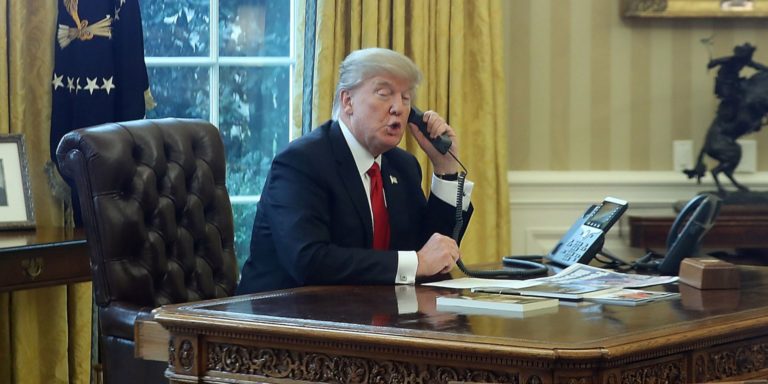It’s been more than a decade since North Korea turned over the remains of American troops missing from the Korean War. So, President Donald Trump’s suggestion Friday that Pyongyang has begun delivering remains to the U.S. raised the hopes of families who have sought closure for more than 60 years.
Still, they’ve been on this roller coaster before, so they are hedging their bets. And U.S. officials across the government quietly acknowledged that so far no remains have been turned over to the U.S. from the North since Trump’s historic meeting with North Korean leader Kim Jong Un.
As of Friday, the Defense POW/MIA Accounting Agency had not received any new remains, according to spokesman Chuck Pritchard. The last time North Korea turned over remains was in 2007, when Bill Richardson, a former U.N. ambassador and New Mexico governor, secured the return of six sets from North Korea.
There are 7,697 U.S. troops still unaccounted for from the Korean War, and about 5,300 of those were lost in North Korea.
Speaking with Fox News on the North Lawn of the White House, Trump said, “they are already starting to produce the remains of these great young soldiers who were left in North Korea. We’re getting the remains, and nobody thought that was possible.”
Trump also appeared to exaggerate the number of those that could be retrieved from North Korea. He said that Kim is “giving us back the remains of probably 7,500 soldiers,” adding that the North Koreans “know where many of these bodies are.”
Keen to talk up the most important diplomacy of his presidency, Trump has made a number of questionable assertions about how the summit in Singapore has transformed relations with Pyongyang. He has said it no longer poses a nuclear threat, although the meeting produced no details on how or when weapons might be eliminated or even reduced.
On Friday, Trump pushed back against those who criticized him for meeting Kim, asserting: “If you don’t agree to meet you know what you’re going to have? You’re going to have nuclear war.” But in a sign of how his unprecedented meeting with the North Korean leader could change hostile ties, he said that now he can call Kim on the phone. “I gave him a very direct number. He can now call me if he has any difficulty. I can call him,” Trump said.
Richard Downes, executive director of the Coalition of Families of Korean & Cold War POW/MIAs, expressed excitement and approval at how Trump had raised the MIA issue with Kim and gotten a commitment to return remains. His airman father Lt. Hal Downes has been missing-in-action since his plane went down over North Korea in 1952.
Downes, who visited North Korea in 2016, said he has since been told the North may have the remains of more than 200 American service members that were likely recovered from land during farming or construction and could be easily returned. But he said the vast majority have yet to be located and retrieved from various cemeteries and battlefields across the countryside.
“It’s exciting, it’s special,” he said about Trump’s comments. “But it’s just words right now. Now, some action has to be taken.”
Over the decades, accounting for U.S. service members from the 1950-1953 Korean War has always been something of a peripheral issue in the fraught relationship between Washington and Pyongyang, and that’s been a source of frustration for family members. More than 36,000 U.S. troops died in the conflict, including those listed as missing in action.
Between 1996 and 2005, joint U.S.-North Korea military search teams conducted 33 joint recovery operations and recovered 229 sets of American remains.
Washington officially broke off the program because it claimed the safety of its searchers was not guaranteed, though the North’s first nuclear test, in 2006, was likely a bigger reason. Critics of the program also argued the North was using the deal to squeeze cash out of Washington, calling it “bones for bucks.” The total cost to the U.S. to carry out the joint missions was $19.5 million.
At the time the program was stopped the U.S. had been due to hunt for remains at the Chosin Reservoir and Unsan province. A new mission would likely return there, Downes said, but would require retraining of U.S. personnel. He said there would only be a few months before winter sets in around October or November and the ground becomes too hard to excavate, meaning work only may begin next spring.
Any return of remains sets a thorough identification process in motion. According to Pritchard, the remains would be sent to one of two Defense Department facilities at Joint Base Pearl Harbor-Hickam in Hawaii, and Offutt Air Force Base in Nebraska.
Scientists would run multiple tests on the remains including DNA and radiological exams, and collect all information available on where they were found and compare that to files of missing troops. A medical examiner would then make a final determination based on all of the facts and then turn the file over to the military service so that the family could be notified.
Just last month, Pritchard said, his agency held a meeting for families in Kentucky, and 68 of the 181 people attending were there seeking information about 36 missing Americans from the Korean War.
“People want their loved ones to come home,” said Pritchard. “If we end up getting remains as a result of this, we will try to identify them and this may bring closure to some families.”
(AP)











One Response
Anyone else tired of all these biased articles? Like please, just the news. No touch-ups or explanations.